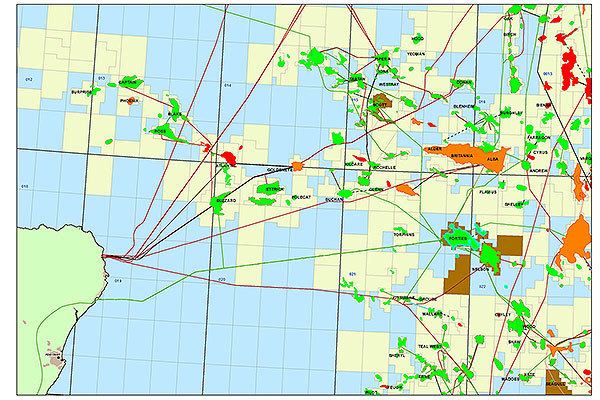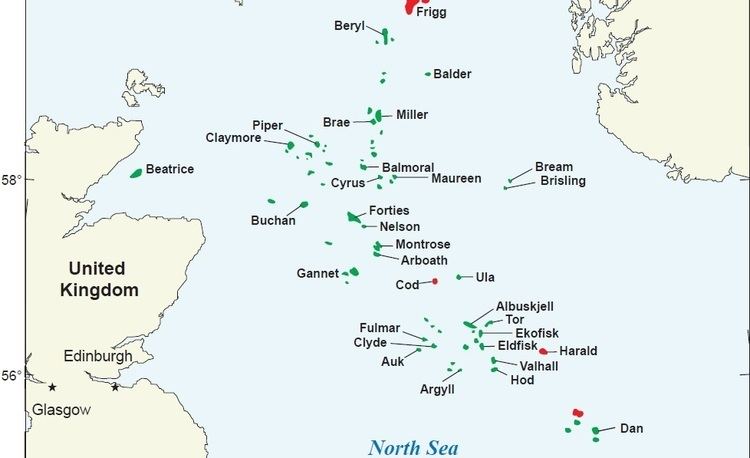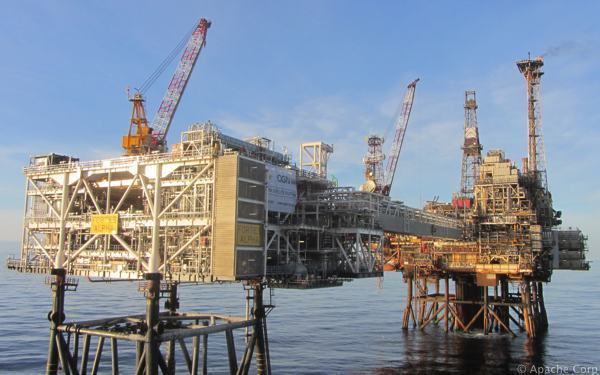Offshore/onshore offshore Discovery 7 October 1970 Operator Apache Corporation | Peak year 1979 Start of production 1975 | |
Estimated oil in place 5,000 million barrels (~6.8×10^ t) | ||
The Forties Oil Field is the largest oil field in the North Sea, 110 miles east of Aberdeen. It was discovered in 1970 and first produced oil in 1975 under ownership of British Petroleum, now called BP.
Contents

History

BP had made the announcement to the press on 7 October 1970, that oil had been struck 110 miles (180 km) east-northeast of Aberdeen in 350 feet (110 m) of water. Production is from the Paleocene Forties Formation sandstones over a 90 km2 area making it a "giant oil field". BP's semi-submersible drilling rig Sea Quest hit crude oil at 11,000 feet (3,400 m) in the Upper Tertiary sandstone.
Four appraisal wells drilled during 1971–1972 revealed a large reservoir at a depth of about 7,000 feet (2,100 m) and closure of 155 m. So marked the first and largest major oil field discovery in the United Kingdom sector of the North Sea. Oil had previously been discovered at the Ekofisk field.

Named Forties because it lay just off the Long Forties Bank, the field began producing oil in September 1975 and was officially inaugurated by Her Majesty on 3 November 1975. When the project was completed, 400,000 barrels of crude was initially expected to be siphoned off each day and exported through a 32-inch pipeline to landfall at Cruden Bay north of Aberdeen. At peak production, this single field would provide the nation with about one-fifth of its total annual requirements by 1978.

Production from the field peaked in 1979 at 500 thousand barrels per day (79 thousand cubic metres per day), well above early predictions.
Reservoir

The Forties Formation consists of a lower Shale Member and an upper Sandstone Member, which were deposited in a "middle and lower submarine fan environment". The initial development plan included a "complete replacement seawater injection system" starting in 1975. By the time BP sold the field in 2003, their reservoir engineers estimated the STOIIP was 4.2 billion barrels (670 million cubic metres).
Development
There are five fixed platforms around the field: Forties Alpha, Forties Bravo, Forties Charlie, Forties Delta and Forties Echo. A riser platform, Forties Unity, lies further to the west and remains owned by BP as a strategic asset for accessing the Forties pipeline system without being dependent on the older access point, Forties Charlie.
In the late 1970s and early 1980s, BP was ubiquitous in the North Sea, owning or partnering with other firms to own the best and biggest fields in the North Sea. BP owned their own commercial deepsea diving company, Subsea International, which serviced their structures and pipelines as well as others worldwide. BP owned a fleet of helicopters, including Sikorsky S-71s used for crew changes on their platforms. The North Sea is typically too rough to make personnel transfers from a crewboat to a rig by basket or ladder, resulting in all crew changes being made by helicopter. North Sea crews typically worked two weeks on, two weeks off. Crews would often wait a day to a week to land on their platform, due to frequent dense fog which prevented landing on the 'Foggy Forties', a hazardous act even in clear weather. BP owned buildings around the airports around the North Sea to accommodate the crews while they were waiting or sometimes stranded in the Shetland Islands en route to the rigs from Aberdeen, Scotland.
Renewal by Apache
The importance of the field has made it a status symbol in the North Sea. When BP sold its 96% share in the field for $812 million in 2003, some traditionalists likened it to selling off the family silver.
Apache Corporation, who bought the field, immediately initiated an intensive re-evalutation of the field and found a further 800 million barrels (130 million cubic metres), extending the field's life by at least twenty years, making the investment by Apache a very profitable one.
Although they lost out on producing the additional reserves directly, retaining the Forties pipeline system allows BP to profit from Apache's exploration investments without needing to invest anything itself.
